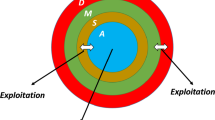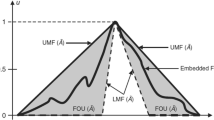Abstract
Tabriz is an ancient city in the northwest of Iran that has experienced many severe earthquakes for a long time. Implementing control strategies in regular buildings can prevent damages in structural members during earthquakes. Fuzzy logic controller is an effective control algorithm that is mostly formulated regarding the human knowledge and expertise. This chapter concentrates on the optimum design of fuzzy logic controllers implemented in a 20-story steel structure with nonlinear behavior using grasshopper optimization algorithm. Regarding the absence of earthquake records for Tabriz, ground motion prediction is necessary for structural seismic analysis. The seismic inputs for nonlinear dynamic analysis are selected thorough the energy-based selection and modification procedure for ground motions by utilizing the probabilistic seismic hazard analysis for Tabriz and ground motion prediction model for Middle East. The results show that the optimization procedure was capable of reducing building responses and damages due to the destructive earthquake records.
Access this chapter
Tax calculation will be finalised at checkout
Purchases are for personal use only
Similar content being viewed by others
References
Cornell CA (1968) Engineering seismic risk analysis. Bull Seismol Soc Am 58(5):1583–1606
Budnitz RJ, Apostolakis G, Boore DM (1997) Recommendations for probabilistic seismic hazard analysis: guidance on uncertainty and use of experts. Nuclear Regulatory Commission, Washington, DC, USA
Mahsuli M, Rahimi H, Bakhshi A (2018) Probabilistic seismic hazard analysis of Iran using reliability methods. Bull Earthq Eng 17:1117–1143
Keshavarz A, Moghaddam BM (2018) Probabilistic seismic hazard analysis and determination of uniform hazard spectrum of Bushehr province assuming linear source model. J Struct Constr Eng 5(1):127–142
Yaghmaei-Sabegh S, Ebrahimi-Aghabagher M (2017) Near-field probabilistic seismic hazard analysis with characteristic earthquake effects. Nat Hazards 87(3):1607–1633
Yazdani A, Nicknam A, Dadras EY, Eftekhari SN (2017) Near-field probabilistic seismic hazard analysis of metropolitan Tehran using region-specific directivity models. Pure APPL Geophys 174(1):117–132
Vafaie J, Taghikhany T, Tehranizade M (2008) Near field uniform seismic hazard spectra of Tabriz zone. In: The 14th world conference on earthquake engineering, Beijing, China, 2008
Vafaie J, Taghikhany T, Tehranizadeh M (2011) Near field effect on horizontal equal-hazard spectrum of Tabriz city in north-west of Iran. Int J Civ Eng 9(1):49–56
Razeghi HR, Amiri GG, Amrei SR, Rahimi MA (2016) Probabilistic seismic hazard analyses and obtaining uniform hazard spectra of Tabriz, Iran. KSCE J Civ Eng 20(5):1813–1823
Moghaddam H, Fanaie N, Hamzehloo H (2009) Uniform hazard response spectra and ground motions for Tabriz. J Sci Iran 16(3):238–248
Hessami K, Pantosti D, Tabassi H, Shabanian E, Abbassi MR, Feghhi K, Solaymani S (2003) Paleoearthquakes and slip rates of the North Tabriz Fault, NW Iran: preliminary results. Ann Geophys 46
Douglas J (2018) Ground-motion prediction equations 1964–2018. Pacific Earthquake Engineering Research Center, Berkeley, CA
Javan‐emrooz H, Eskandari‐Ghadi M, Mirzaei N (2018) Prediction equations for horizontal and vertical PGA, PGV, and PGD in Northern Iran using prefix gene expression programming. Bull Seismol Soc Am 108
Sedaghati F, Pezeshk S (2017) Partially nonergodic empirical ground-motion models for predicting horizontal and vertical PGV, PGA, and 5% damped linear acceleration response spectra using data from the Iranian Plateau. Bull Seismol Soc Am 107(2):934–948
Rajabi AM, Khamehchiyan M, Mahdavifar MR, Del Gaudio V (2010) Attenuation relation of Arias intensity for Zagros Mountains region (Iran). Soil Dyn Earthq Eng 30(3):110–118
Sandıkkaya MA, Akkar S (2017) Cumulative absolute velocity, Arias intensity and significant duration predictive models from a pan-European strong-motion dataset. Bull Earthq Eng 15(5):1881–1898
Gupta ID, Trifunac MD (2017) Scaling of Fourier spectra of strong earthquake ground motion in western Himalaya and northeastern India. Soil Dyn Earthq Eng 102:137–159
Alıcı FS, Sucuoğlu H (2016) Prediction of input energy spectrum: attenuation models and velocity spectrum scaling. Earthq Eng Struct Dyn 45(13):2137–2161
Hassani N, Amiri GG, Bararnia M, Sinaeian F (2017) Ground motion prediction equation for inelastic spectral displacement in Iran. Sci Iran Trans B Mech Eng 24(1):164
Oth A, Miyake H, Bindi D (2017) On the relation of earthquake stress drop and ground motion variability. J Geophys Res: Solid Earth 122(7):5474–5492
Yaghmaei-Sabegh S (2018) Macroseismic intensity attenuation in Iran. Earthq Eng Eng Vibr 17(1):139–148
Yaghmaei-Sabegh S (2015) New models for frequency content prediction of earthquake records based on Iranian ground-motion data. J Seismol 19(4):831–848
Afshari K, Stewart JP (2016) Physically parameterized prediction equations for significant duration in active crustal regions. Earthq Spectra 32(4):2057–2081
Haji-Soltani A, Pezeshk S, Malekmohammadi M, Zandieh A (2017) A study of vertical-to-horizontal ratio of earthquake components in the Gulf coast region. Bull Seismol Soc Am 107(5):2055–2066
Al-Dawod M, Samali B, Kwok K, Naghdy F (2004) Fuzzy controller for seismically excited nonlinear buildings. J Eng Mech 130(4):407–415
Fu J, Lai J, Liao G, Yu M, Bai J (2018) Genetic algorithm based nonlinear self-tuning fuzzy control for time-varying sinusoidal vibration of a magnetorheological elastomer vibration isolation system. Smart Mater Struct
Soltani M, Chaouech L, Chaari A (2018) Fuzzy sliding mode controller design based on Euclidean particle swarm optimization. In: Real-time modelling and processing for communication systems. Springer, Cham, pp 95–122
Chen Z, Yuan X, Yuan Y, Lei X, Zhang B (2018) Parameter estimation of fuzzy sliding mode controller for hydraulic turbine regulating system based on HICA algorithm. Renew Energy
Olivas F, Valdez F, Castillo O, Gonzalez CI, Martinez G, Melin P (2017) Ant colony optimization with dynamic parameter adaptation based on interval type-2 fuzzy logic systems. Appl Soft Comput 53:74–87
Amador-Angulo L, Castillo O (2018) A new fuzzy bee colony optimization with dynamic adaptation of parameters using interval type-2 fuzzy logic for tuning fuzzy controllers. Soft Comput 22(2):571–594
Chamorro HR, Riaño I, Gerndt R, Zelinka I, Gonzalez-Longatt F, Sood VK (2019) Synthetic inertia control based on fuzzy adaptive differential evolution. Int J Electr Power Energy Syst 105:803–813
Ray PK, Paital SR, Mohanty A, Eddy FY, Krishnan A, Gooi HB, Amaratunga GA (2018) Firefly algorithm scaled fractional order fuzzy PID based PSS for transient stability improvement. In 2018 19th international Carpathian control conference (ICCC) 28 May 2018. IEEE, pp 428–433
Chrouta J, Chakchouk W, Zaafouri A, Jemli M (2018) Modelling and control of an irrigation station process using heterogeneous cuckoo search algorithm and fuzzy logic controller. IEEE Trans Ind Appl
Giri S, Bera P (2018) Design of fuzzy-PI controller for hybrid distributed generation system using grey wolf optimization algorithm. In: Methodologies and application issues of contemporary computing framework. Springer, Singapore, pp 109–122
Chao F, Zhou D, Lin CM, Zhou C, Shi M, Lin D (2018) Fuzzy cerebellar model articulation controller network optimization via self-adaptive global best harmony search algorithm. Soft Comput 22(10):3141–3153
Li C, Mao Y, Zhou J, Zhang N, An X (2017) Design of a fuzzy-PID controller for a nonlinear hydraulic turbine governing system by using a novel gravitational search algorithm based on Cauchy mutation and mass weighting. Appl Soft Comput 52:290–305
Talatahari S, Azizi M (2020) Chaos Game Optimization: a novel metaheuristic algorithm. Artif Intell Rev 22:1–88. https://doi.org/10.1007/s10462-020-09867-w
Talatahari S, Azizi M (2020) Optimization of constrained mathematical and engineering design problems using chaos game optimization. Comput Ind Eng 20:106560. https://doi.org/10.1016/j.cie.2020.106560
Talatahari S, Azizi M (2020) Optimal design of real-size building structures using quantum-behaved developed swarm optimizer. Struct Des Tall Spec Build 15:e1747. https://doi.org/10.1002/tal.1747
Talatahari S, Motamedi P, Farahmand Azar B, Azizi M (2019) Tribe-charged system search for parameter configuration of non-linear systems with large search domains. Eng Optim. https://doi.org/10.1080/0305215X.2019.1696786
Azizi M, Ejlali RG, Ghasemi SA, Talatahari S (2019) Upgraded Whale Optimization Algorithm for fuzzy logic based vibration control of nonlinear steel structure. Eng Struct 1(192):53–70. https://doi.org/10.1016/j.engstruct.2019.05.007
Azizi M, Ghasemi SA, Ejlali RG, Talatahari S (2020) Optimum design of fuzzy controller using hybrid ant lion optimizer and Jaya algorithm. Artif Intell Rev 53(3):1553–1584. https://doi.org/10.1007/s10462-019-09713-8
Azizi M, Ghasemi SA, Ejlali RG, Talatahari S (2019) Optimal tuning of fuzzy parameters for structural motion control using multiverse optimizer. Struct Des Tall Spec Build 28(13). https://doi.org/10.1002/tal.1652
Talatahari S, Azizi M (2020) Optimum design of building structures using tribe-interior search algorithm. Structures
Azizi M, Ghasemi SA, Ejlali RG, Talatahari S (2021) Optimization of fuzzy controller for nonlinear buildings with improved charged system search. Struct Eng Mech
Kaveh A, Pirgholizadeh S, Khadem HO (2015) Semi-active tuned mass damper performance with optimized fuzzy controller using CSS algorithm. Asian J Civ Eng (BHRC) 16(5):587–606
Abubaker S, Nagan S, Nasar T (2016) Particle swarm optimized fuzzy control of structure with tuned liquid column damper. Global J Pure Appl Math 12(1):875–886
Saremi S, Mirjalili S, Lewis A (2017) Grasshopper optimisation algorithm: theory and application. Adv Eng Softw 105:30–47
Ambraseys NN, Simpson KU, Bommer JJ (1996) Prediction of horizontal response spectra in Europe. Earthq Eng Struct Dynam 25(4):371–400
Marasco S, Cimellaro GP (2018) A new energy-based ground motion selection and modification method limiting the dynamic response dispersion and preserving the median demand. Bull Earthq Eng 16(2):561–581
Karakhanian AS, Trifonov VG, Philip H, Avagyan A, Hessami K, Jamali F, Bayraktutan MS, Bagdassarian H, Arakelian S, Davtian V, Adilkhanyan A (2004) Active faulting and natural hazards in Armenia, eastern Turkey and northwestern Iran. Tectonophysics 380(3–4):189–219
Berberian M, Yeats RS (1999) Patterns of historical earthquake rupture in the Iranian Plateau. Bull Seismol Soc Am 89(1):120–139
Masson F, Djamour Y, Van Gorp S, Chéry J, Tatar M, Tavakoli F, Nankali H, Vernant P (2006) Extension in NW Iran driven by the motion of the South Caspian Basin. Earth Planet Sci Lett 252(1–2):180–188
Cimellaro GP, Marasco S (2014) OPENSIGNAL: a software framework for earthquake record processing and selection. In: Second European conference on earthquake engineering and seismology (2ECSEES), Istanbul, Turkey Google Scholar
Cimellaro GP, Marasco S (2015) A computer-based environment for processing and selection of seismic ground motion records: OPENSIGNAL. Front Built Environ 1:17
Mirjalili SZ, Mirjalili S, Saremi S, Faris H, Aljarah I (2018) Grasshopper optimization algorithm for multi-objective optimization problems. Appl Intell 48(4):805–820
Ullah I, Khitab Z, Khan MN, Hussain S (2019) An efficient energy management in office using bio-inspired energy optimization algorithms. Processes 7(3):142
Newmark NM (1959) A method of computation for structural dynamics. J Eng Mech Div 85(3):67–94
Subbaraj K, Dokainish MA (1989) A survey of direct time-integration methods in computational structural dynamics—II. Implicit methods. Comput Struct 32(6):1387–1401
Ohtori Y, Spencer Jr BF (1999) A MATLAB-based tool for nonlinear structural analysis. In: Proceedings of the 13th engineering mechanics conference, pp 13–16
MATLAB, the MathWorks Inc., MA, United States
Author information
Authors and Affiliations
Corresponding author
Editor information
Editors and Affiliations
Rights and permissions
Copyright information
© 2021 The Author(s), under exclusive license to Springer Nature Singapore Pte Ltd.
About this chapter
Cite this chapter
Azizi, M. (2021). Designing Fuzzy Controllers for Frame Structures Based on Ground Motion Prediction Using Grasshopper Optimization Algorithm: A Case Study of Tabriz, Iran. In: Carbas, S., Toktas, A., Ustun, D. (eds) Nature-Inspired Metaheuristic Algorithms for Engineering Optimization Applications. Springer Tracts in Nature-Inspired Computing. Springer, Singapore. https://doi.org/10.1007/978-981-33-6773-9_8
Download citation
DOI: https://doi.org/10.1007/978-981-33-6773-9_8
Published:
Publisher Name: Springer, Singapore
Print ISBN: 978-981-33-6772-2
Online ISBN: 978-981-33-6773-9
eBook Packages: Intelligent Technologies and RoboticsIntelligent Technologies and Robotics (R0)




